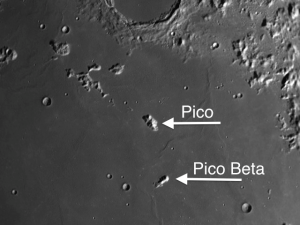 The week of Jan. 8-14 takes us from the end of Day 22 (waning crescent) to Day 27. On Monday the Moon won’t be high enough to view until 2:00 a.m. This week we will highlight Mons Pico and the crater Birt, viewable early Tuesday morning.
The week of Jan. 8-14 takes us from the end of Day 22 (waning crescent) to Day 27. On Monday the Moon won’t be high enough to view until 2:00 a.m. This week we will highlight Mons Pico and the crater Birt, viewable early Tuesday morning.
Mons Pico: [NW/E9] As the terminator is approaching Plato early Tuesday morning, the redundantly named Mount Pico1 and its little brother Pico &U0392; (Beta), about 25 miles to its south, are striking, statuesque features which stand sentinel on the lava plains of Mare Imbrium. The “Brothers Pico” are surviving  fragments of what was at one time the magnificent inner ring of the Imbrium basin, which was created 3.9 billion years ago when an asteroid 60 miles in diameter slammed into the Moon at 10 miles per second and blasted out a 720-mile-wide crater! Mount Pico towers an impressive 1.5 miles over the plains below!
fragments of what was at one time the magnificent inner ring of the Imbrium basin, which was created 3.9 billion years ago when an asteroid 60 miles in diameter slammed into the Moon at 10 miles per second and blasted out a 720-mile-wide crater! Mount Pico towers an impressive 1.5 miles over the plains below!
Birt: [SW/M9] Just to the west of Straight Wall, a showcase feature which was discussed in a previous blog, you will find the small 10-mile crater Birt. Like Aristarchus (Day 11), Birt has interior bands running up its wall, although they are not as prominent. At 10 miles in diameter, Birt is pretty small, so the bands may not be immediately obvious.
1“Pico” is Spanish for peak.
======================
It is highly recommended that you get a copy of Sky and Telescope’s Field Map of the Moon, the very finest Moon map available for use at the telescope. It is available for $10.95 at www.skyandtelescope.com and on Amazon. All features mentioned in this blog will be keyed to the grid on the Field Map and will look like this: Plato: [NW/D9]
Credits:
Courtesy of Gray Photography of Corpus Christi, Texas
Lunar photos: NASA / USGS / BMDO / LROC / ASU / DLR / LOLA / Moon Globe. Used by permission
- Trio of Moon Craters with Distinct Personalities - April 22, 2024
- Hippalus Rilles on the Moon - April 15, 2024
- Moon Crater Janssen: How New Moon Craters are Superimposed on Top of Older Craters - April 8, 2024
I recommend using the small crater that is in the center of the Plato crater as the “touchstone” of the quality etc of your telescope, lenses, photographic equipment. If it is seen the small central crater is that the performance of the equipment is reasonably good, but the ideal is to get to see or photograph the 4 or 5 small craters that are inside the crater Plato